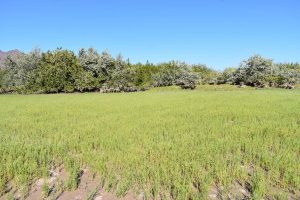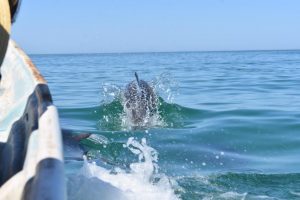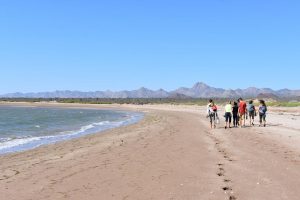We have just gotten back from a weekend of camping here along the Infiernillo, where our class has seen and experienced such a variety of sights, sounds, and stories that it is hard to tie things together into one coherent blog post. What do estuaries in the desert, sea turtles, and the Seri (Comca’ac) native community’s conservation philosophies all have in common? I’ll sum it up in a color: green.

In a place like the Sonora Desert, I wasn’t expecting to see much of the lush, vibrant chlorophyll I’m used to from back home in North Carolina. I’d spent the first half of the week adjusting my worldview to accommodate for the red-brown dust that coated everything, the blinding blues of the sky and sea, and the muted green-brown of the sparse cacti and other limited vegetation. Here in the Infiernillo channel though, where we explored nonstop and camped from Friday to Sunday, when we rounded the bend on our panga boat into the first estuary we stopped at, I was stunned: a lush green, brighter than the limones we’ve been eating nonstop welcomed my tired eyes. I soon learned it was thanks to the succulent Salicornia plant that grew along the mangroves’ edge, a plant that Ernesto, one of the Comca’ac native community members and our boat captain, informed us later that the community had been using in soups and turtle dishes for ages.
Which brings me to my second source of green: turtles. The green sea turtle, species name Chelonia mydas, goes by eight different names in the Seri community – their knowledge of sub-populations in the area is that minutely detailed. It’s so detailed, in fact, that Jose Luiz, another of our guides, knew the exact spot where these beautiful creatures ate eelgrass all morning in the channel, and could point one out to us on the boat before it even surfaced for air. We paused for several minutes (probably only a single turtle breath) in this tranquil environment to observe, and only then did I begin to be able to pick out the shadows of the turtles swimming below on my own. Being in such close proximity to both fantastic creatures as well as vast knowledge seemed like a running theme this weekend; we were constantly brought to the exact spots where dolphins played alongside our boat, pen shell fishers dove for callo, or fin whales stranded on the rocky shore. Each of these experiences felt like such a lucky, rare moment, but really, they must not have been coincidence. The only thing we were lucky about was being privy to the wealth of knowledge that these fishers have about their land and home.

I think it’s this deep wealth of knowledge that made learning about the Comca’ac’s perspectives on “being green” – or their conservation and sustainability philosophies – here in Sonora, Mexico, so impactful to me this weekend. Sitting around the campfire and listening to various members of group complain, explain, and outline the history of certain conservation issues in the area was a lot to take in. There were often points where group members voiced clear dismay at the practices of fishers we had met in Kino just days earlier, or even at conservationists from the United States in general. Even if it isn’t easy to tell where this distrust comes from, or what should be done about it, it was quite easy to tell that the Comca’ac philosophy of “respecting the animals of the sea and the land” (according to Ernesto) is a belief system built on a history knowledge and respect.
And in a place as beautiful and complex as the Infiernillo it’s easy to see why – if you pay attention for even as long as a turtle breath – you’d want to respect it and keep it that way.

